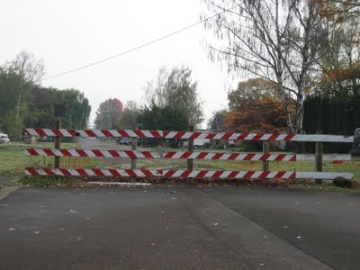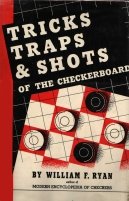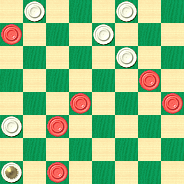The Checker Maven
Jump to navigationBuchanan's Block

Sometimes, progress is simply blocked. For example, in our photo above, we're not going to be able to travel any further along this road, given the rather substantial looking roadblock that's right in front of us. But at least we have the option of turning around and trying another route.
In the game of checkers, a "block" means something similar. Our pieces might be blocked from going in a certain direction, and we have to seek another (though unless they're kings they can't turn around and go back). But if all of our pieces are blocked in all directions, we have a problem for sure: we've lost the game!
In his famous Tricks Traps & Shots of the Checkerboard, author Willie Ryan serves up various examples of blocks for our entertainment and tuition. Here's an over-the-board example that we'll let Willie tell us about it personally.

"Former American Champion Edwin F. Hunt, of Nashville, Tennessee, once defined Checkers as a "battle of ideas." The more ideas or strategic devices the learner can create or anticipate as he plays a game, the more skillful and versatile he becomes. Here is an artistic game I played several years ago with Basil Case, in which I managed to save what appeared to be a hopeless position by utilizing a block or smother idea.
| 9-14 | 18-15 | 6-10 |
| 22-18 | 7-11 | 24-20 |
| 5- 9 | 29-25 | 16-19 |
| 24-19 | 11-18 | 20-16 |
| 11-15 | 23-14 | 19-24 |
| 18-11 | 8-11 | 16-12 |
| 8-24 | 25-22 | 10-15 |
| 28-19 | 11-16 | 11-8 |
| 4- 8 | 14-10---2 | 2-7 |
| 25-22 | 6-24 | 8-4 |
| 9-13---1 | 27-11 | 24-28 |
| 22-18 | 12-16 | 4- 8 |
| 14-17 | 31-27 | 7-11 |
| 21-14 | 1-6 | 8- 4---A |
| 10-17 | 27-24 |
This brought about the diagrammed position.

BLACK
Black to Play and Draw
B:W32,30,26,22,12,K4:B28,17,15,13,11,3.
A---Forms a position with which the great George Buchanan of Scotland gained a draw against Thomas Ballantyne in the 1897 Scottish Championship Tourney."
1---Definitely not best; 8-11 would be good here---Ed.
2---Gives up the edge; 27-23 would have held on to a definite White advantage---Ed.
Can you find your way out of the situation and achieve a Black draw, or will you encounter a mental block? We hope not, but we won't try to block your mouse from clicking on Read More to reveal the solution.![]()
Solution
"Continue: 15-18*!, 22-8,17-22, 26-17,13-22, 32-27, 22-26*---B, 30-23, 28-32, 27-24, 32-27, 23-18, 27-20, 18-15, 20-16; a draw---3.
B---An unusual ending, in which black must force a draw with three pieces short. Crowning 28-32 will lose to 27-23*, 32-27, 23-18*, 27-23, 18-14, etc."
3---White is up four pieces to two, but three of the White pieces can't even move---Ed.
You can email the Webmaster with comments on this article.
